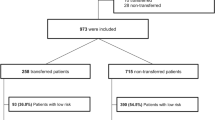Abstract
The diagnosis of a ruptured abdominal aortic aneurysm in a patient presenting to the emergency department of a rural hospital without in-house vascular surgery facilities creates a stressful situation for the emergency physician or general surgeon on duty who needs to assess the feasibility of the patient’s inter-hospital transfer to a vascular surgery unit, particularly in terms of transfer time. We have searched the literature for relevant studies as to whether the delay incurred by the inter-hospital transfer of a patient with ruptured abdominal aortic aneurysm has any impact on the prognosis of these patients. Few studies, all of which were retrospective, have focused on the relationship between inter-hospital transfer time and mortality; their findings suggested that the additional time spent on the inter-hospital transfer of patients with ruptured abdominal aortic aneurysm does not aggravate their mortality rate.
Similar content being viewed by others
References
Mandawat A, Mandawat A, Sosa JA, et al. Endovascular repair is associated with superior clinical outcomes inpatients transferred for treatment of ruptured abdominal aortic aneurysms. J Endovasc Ther 2012;19:88–95
Mell MW, Callcut RA, Bech F, et al. Predictors of emergency department death for patients presenting with ruptured abdominal aortic aneurysms. J Vasc Surg 2012;56:651–655
Dueck AD, Kucet DS, Johnston KW, et al. Survival after ruprured abdominal aortic aneurysm: effect of patient, surgeon, and hospital factors. J Vasc Surg 2004;39:1253–1260
Hinchliffe RJ, Ribbons T, Ulug P, et al. Transfer of patients with ruptured abdominal aortic aneurysm from general hospitals to specialist vascular centres: results of a Delphi consensus study. Emerg Med J 2013;306:483–486
Maybury RS, Chang DC, Freischlag JA. Rural hospitals face a higher burden of ruptured abdominal aortic aneurysm and are more likely to transfer patients for emergent repair. J Am Coll Surg 2011;212:1061–1067
Azizzadeh A, Miller CC, Villa MA, et al. Effect of patient transfer on outcomes after open repair of ruptured abdominal aortic aneurysms. Vascular 2009;17:9–14
Hames H, Forbes TL, Harris JR, et al. The effect of patient transfer on outcomes after rupture of an abdominal aortic aneurysm. Can J Surg 2007;50:43–47
Salhab M, Farmer J, Osman I. Impact of delay on survival in patients with ruptured abdominal aortic aneurysm. Vascular 2006;14:38–43
Souza VC, Strachan DP. Relationship between travel time to the nearest hospital and survival from ruptured abdominal aortic aneurysms: record linkage study. J Pub Health 2005;27:165–170
Adam DJ, Mohan IV, Stuart WP, et al. Community and hospital outcome from ruptured abdominal aortic aneurysm within the catchment area of a regional vascular surgical service. J Vasc Surg 1999;30:922–928
Farooq MM, Freischlag JA, Seabrook GR, et al. Effect of the duration of symptoms, transport time, and length of emergency room stay on morbidity and mortality in patients with ruptured abdominal aortic aneurysms. Surgery 1996;119:9–14
Vogel TR, Nackman GB, Brevetti LS, et al. Resource utilization and outcomes: effect on outcomes on patients with ruprured abdominal aortic aneurysms. Ann Vasc Surg 2005;19:149–153
Lloyd GM, Bown MJ, Norwood MJ, et al. Feasibility of preoperative computer tomography in patients with ruptured abdominal aortic aneurysm: a time to death study in patients without operations. J Vasc Surg 2004;39:788–791
Theodorou D, Toutoyzas K, Drimousis P, et al. emergency room management of trauma patients in Greece: preliminary report of a national study. Resuscitation 2009;80:350–353
Wiegersma JS, Droogh JM, Zijlstra JG, et al. Quality of interhospital transport of the critically ill: impact of a mobile intensive care unit with a specialized retrieval team. Critical Care 2011;15:1–8
Assar AN, Zarins CK. Ruptured abdominal aortic aneurysm: a surgical emergency with many clinical presentations. Postgrad Med J 2009;85:268–273
Smith N. Management of the ruptured abdominal aortic aneurysm: challenges facing paramedics. J Paramedic Practice 2011;3:360–365
Author information
Authors and Affiliations
Corresponding author
Rights and permissions
About this article
Cite this article
Papagoras, D., Kanara, M. Does the transfer time of a patient with ruptured abdominal aortic aneurysm play a significant role in survival?. Hellenic J Surg 86, 150–154 (2014). https://doi.org/10.1007/s13126-014-0117-x
Received:
Accepted:
Published:
Issue Date:
DOI: https://doi.org/10.1007/s13126-014-0117-x




